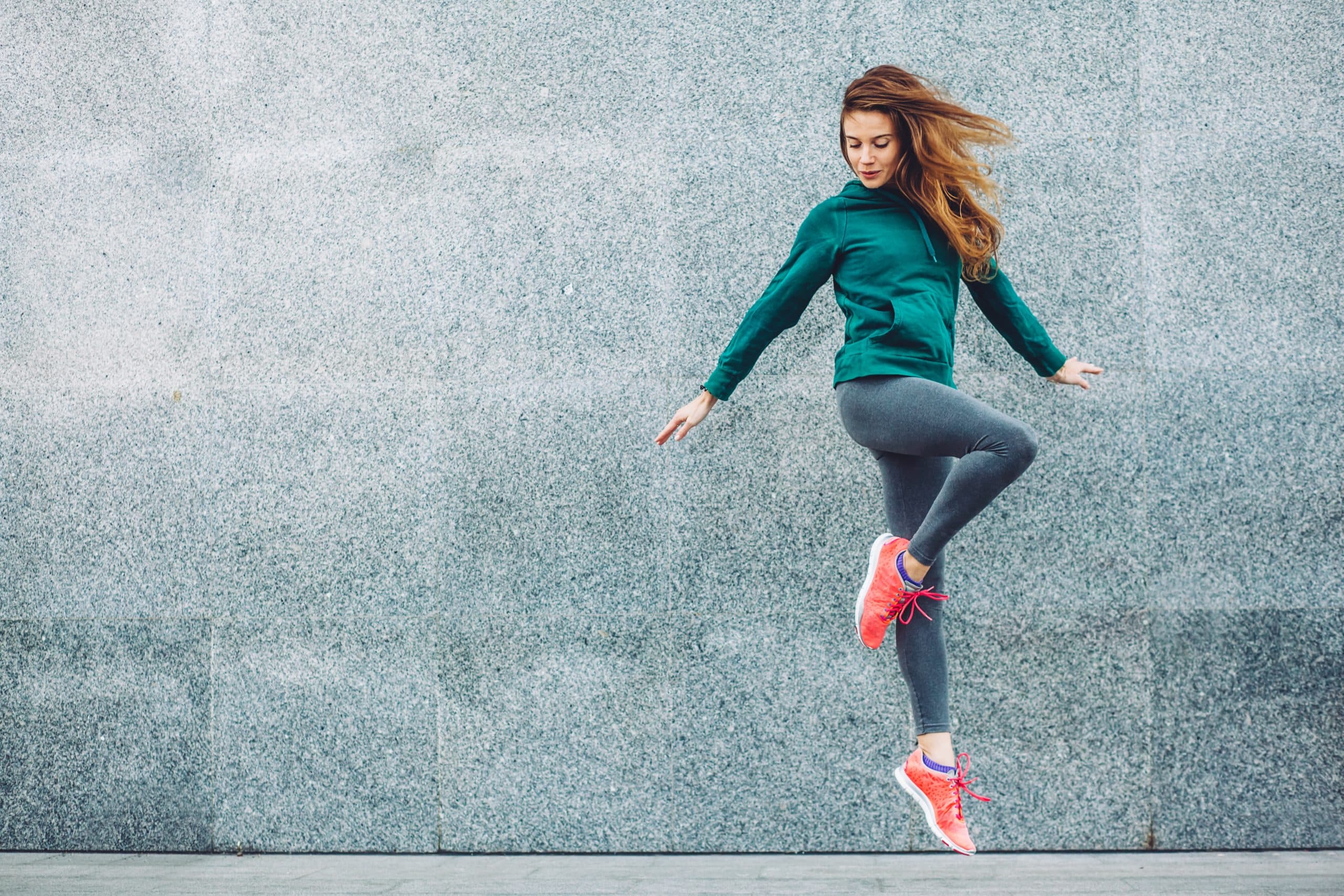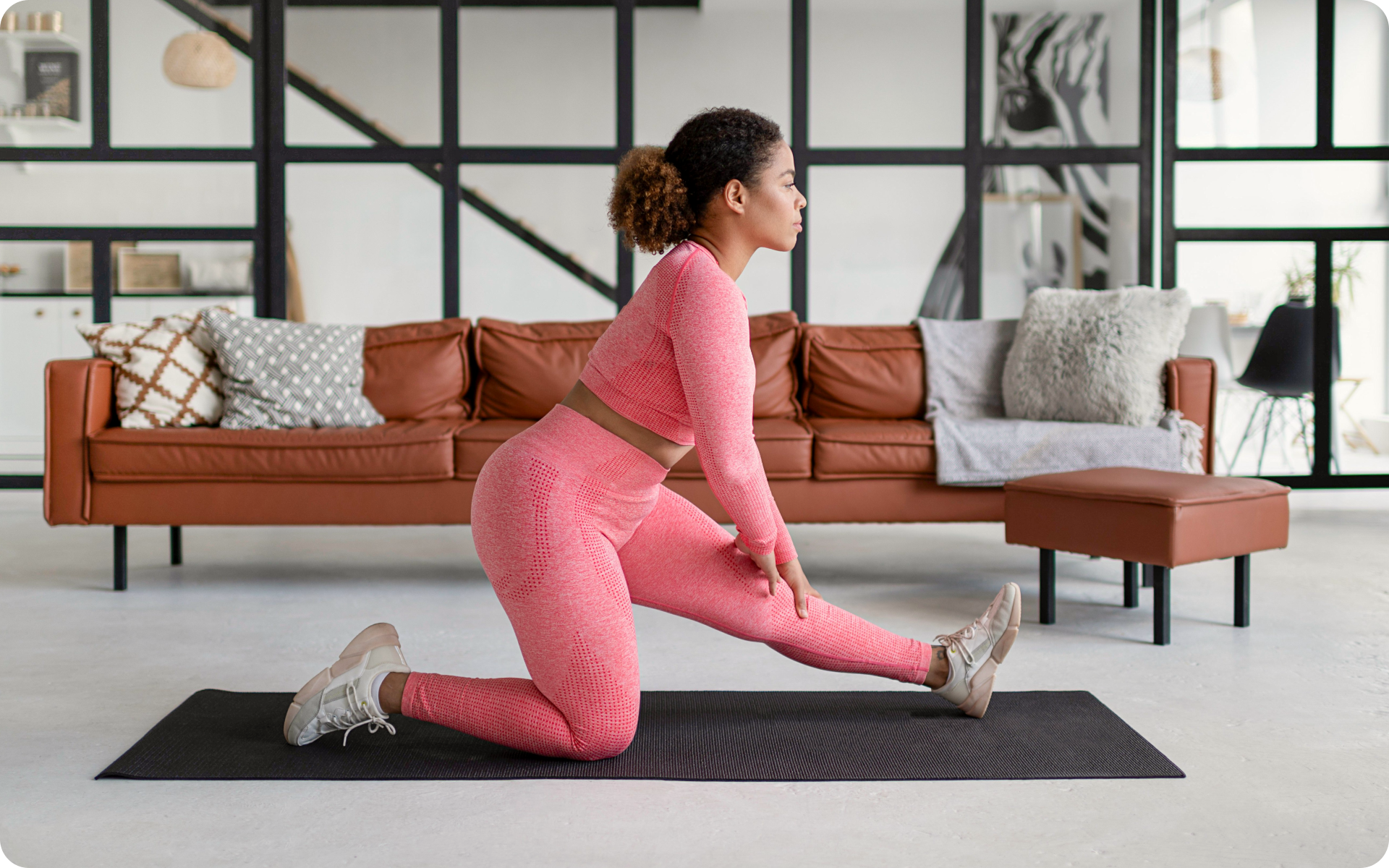You may think that having fat in one specific area of your body, such as on the hips, is a result of some dietary misstep or lack of exercise, but the truth is, that’s not always the case.
In reality, genetics can play a significant role in where your body stores fat. Some people may find that they accumulate fat more around their midsection, while others may notice it more on their hips and thighs. Even your hormones can influence this distribution (7).
So if your problem area happens to be your hips, you might be wondering how you can lose that hip fat and keep it off for good.
While there’s no way to spot-reduce fat from specific areas, there are many ways of improving your body composition, reducing overall body fat, and ultimately slimming down those hips. Here’s what you need to know.
How to Lose Hip Fat, Forever
A common challenge people face is losing weight for a while, and then gaining it all back. You can blame this on a lack of motivation, busy life events, or a return to old habits, but when it comes down to it, most methods that claim to reduce hip fat in 10 days, or any other short timeframe, are simply not sustainable.
You might see results in the short term, but this is generally at a cost to your overall health. These methods often involve quick fixes such as fad diets or extreme exercise routines that aren’t maintainable for the long haul. In addition, they can be detrimental to your mental and emotional well-being.
Want to build an attention-grabbing bubble butt, blast away fat that’s stored in all the wrong places, spring-clean your diet, turn back the clock on your skin, skyrocket your self-confidence and shatter your insecurities? Check out the BetterMe app and set this plan in motion!
So instead, here are some surefire ways of losing hip fat for men and women that are backed by science and can help you keep it off for good.
Exercise
This sounds like a no-brainer, but you would be surprised how many people don’t exercise to lose hip fat and look for other shortcuts. The key to success is not just exercising but moving in a way that is suitable for your current physical capacity. (5).
Resistance Training
Resistance training, such as weight lifting or body-weight exercises, helps build muscle and increase your metabolism. As you gain more muscle mass, the more calories you will burn throughout the day, including while you are at rest (6). This is a win-win situation as it can means less fat on your hips.
Here are the best exercises for losing hip fat that can be performed with or without weights:
Squats
Squats are a great exercise for losing hip fat. They work your entire lower body, including the hips, buttocks, and legs.
- Stand with your feet hip-width apart
- Extend your arms out straight so they are parallel to the ground
- Push your hips back and bend your knees, lowering your body to a depth you’re confident with
- Keep your chest upright and your knees tracking over your midfoot
- Drive through your legs to return to the starting position
- Repeat this movement for the desired number of reps
- Squats can be modified to increase intensity, such as by holding dumbbells or a barbell
- Remember to keep your spine neutral during the exercise
- Ensure that you can engage your core throughout the movement
Hip Bridges
Hip bridges target the muscles in your hips, glutes, and lower back.
- Lie flat on your back with your knees bent, feet flat on the floor
- Keep your arms by your sides and palms flat on the floor
- Lift your hips off the floor while maintaining a straight line from shoulders to knees
- Squeeze your glutes at the top of the movement
- Lower your hips back to the floor
- Repeat for the desired number of reps
- Control the movement and don’t allow your hips to drop
- Add a resistance band or hold a weight on your hips for added intensity
- Remember to engage your core throughout the movement
- Keep your gaze straight up to ensure you maintain good alignment
Lunges
Lunges are another highly effective exercise for working the hip muscles.
- Stand upright with your feet hip-width apart
- Take a large step forward with one foot, then lower your knee toward the ground,
- Both legs should bend to form right angles at the knees – your front knee should be directly above your ankle and your other knee should be just above the ground
- Keep your upper body straight and look straight ahead
- Push through your heels to come back up to the standing position
- Repeat with the other leg and continue to alternate
- To increase the challenge, hold dumbbells at your sides
Step-ups
Step-ups are among the hip flexor exercises that specifically target the hips and thighs.
- Stand in front of a sturdy step or bench that’s roughly knee height
- Step up with one foot onto the step, then press down through your heel to lift your entire body up
- Step down with the same foot, then repeat with the other foot
- Maintain good posture throughout the exercise
- To increase the intensity, hold dumbbells in both hands
Side Leg Raises
Side leg raises help shape the hips and thighs while also strengthening the core.
- Stand with your feet shoulder-width apart
- Shift your weight to one leg, then lift the other leg out to the side as high as comfortably possible
- Lower your leg back down, then repeat on the other side
- Keep your upper body stable and avoid tilting to the side as you lift your leg
- To increase the challenge, add ankle weights or use a resistance band around your ankles
Read more: 7 Hip-Strengthening Exercises for Runners to Improve Flexibility and Correct Imbalances
Cardio
Cardiovascular exercises such as running and cycling can be effective for reducing overall body fat, which includes that on the hips. Running burns a significant amount of calories and plays a crucial role in reducing body fat percentage (6).
You can find out more about building a running habit for weight loss in our article about hip-strengthening exercises for runners.
Diet
As the saying goes, you can’t out-exercise a bad diet. And while spot-reducing fat is not possible, you can still make dietary changes that will help reduce overall body fat and therefore, hip fat (11).
Cut Back on Added Sugars
Sugary drinks and foods can quickly add up calories with little or no nutritional value. You should aim to limit your intake of added sugars and opt for natural sweeteners or whole fruits instead (11).
Increase Protein Intake
Protein is essential for building and maintaining muscle mass, which can help boost your metabolism and help with fat loss. Include protein-rich foods throughout your day, including lean meats, fish, eggs, tofu, and legumes (4).
Consume Healthy Fats
Contrary to popular belief, fats are an important part of a balanced diet and they can actually help with weight loss. You should focus on incorporating healthy fats such as avocados, olive oil, nuts, and seeds into your meals for added satiety (1).
Hydrate
Drinking enough water is essential for overall health and can also help with weight loss. Sometimes, our bodies may mistake thirst for hunger, which leads to overeating. Keep hydrated throughout the day by sipping on water or occasionally, low-calorie beverages (8).
Other Lifestyle Changes
To ensure exercise and diet really stick and be effective in the long term, you must create the right environment. A supportive environment that encourages healthy habits can make all the difference.
Some lifestyle changes that can help you stay consistent include:
- Improving sleeping hygiene – aim for 7-9 hours of quality sleep every night
- Reducing stress levels – try incorporating relaxation techniques such as deep breathing or meditation into your daily routine
- Surrounding yourself with like-minded individuals who also prioritize their health and fitness
- Creating a realistic and sustainable plan that suits your lifestyle and allows for flexibility
- Focusing on progress, not perfection, and celebrating small victories along the way
What Causes Fat on the Hips?
Fat on the hips may be caused by one, or a combination of factors, such as genetics, hormones, or lifestyle habits.
Genetics
Your DNA can play a significant role in the distribution of body fat. Researchers believe that genes influence the number and size of fat cells in different areas of the body, including the hips (7). So if you have a family history of wider hips or larger thighs, it’s likely you may also struggle with excess hip fat.
Hormones
Your hormones can also impact where your body stores fat. During puberty, women tend to gain weight around their hips and thighs. This is a natural process and the fat is necessary for proper reproductive function.
However, hormonal imbalances, such as those that are caused by polycystic ovary syndrome (PCOS), can result in excess fat storage in the hips and thighs. This is because increased insulin levels are common in PCOS, which can promote fat storage in these areas (10).
Lifestyle Habits
Lifestyle habits also play a significant role in the accumulation of hip fat. Why? Well, a diet that is high in processed foods, refined sugars, and unhealthy fats can cause weight gain and fat storage around the hips.
In addition, a sedentary lifestyle with little physical activity can contribute to excess hip fat.
That’s not all, though. A lack of sleep, high stress levels, and certain medications can also affect hormones and metabolism, which makes it easier to gain weight and store fat on the hips (9).
Even seemingly unrelated factors, including smoking or drinking alcohol, can contribute to excess hip fat (2).
For example, smoking can increase cortisol levels (the stress hormone) and lead to fat storage in the abdominal area, including the hips, while excessive alcohol consumption increases calorie intake and hinders fat loss efforts (12).
When it comes to weight loss, progress is made by inches, not miles, so it’s much harder to track and a lot easier to give up. BetterMe app is your personal trainer, nutritionist and support system all in one. Start using our app to stay on track and hold yourself accountable!
Is Hip Fat Stubborn?
Yes, hip fat is stubborn. Stubborn fat is a term that is used to describe fat that is challenging to lose, even with diet and exercise. This type of fat generally has a higher concentration of alpha-receptors, which slow down the fat-burning process (3).
These receptors are more abundant in areas such as the hips, thighs, and lower abdomen (3), which makes it harder to lose fat from these areas. That is why you may notice that even when you’re losing weight overall, your hip fat seems to stick around.
Trying to lose hip fat fast may be quite frustrating, but unfortunately, there’s no magic solution. This doesn’t mean that it’s completely impossible, but it may take a bit more time and effort to see results.
Why Is Hip Fat So Hard to Lose?
Hip fat requires more effort to lose because it is made up of stubborn fat cells. These cells are more resistant to traditional weight loss methods and may require a combination of approaches before you see results (3).
In addition, spot-reducing fat from specific areas is not possible. When you lose weight, your body decides which fat stores to use for energy based on genetics and other factors. This means that even if you are doing targeted exercises for your hips, it may take some time for the fat in that area to be utilized.
How Long Does It Take to Lose Hip Fat?
If you’re consistently exercising and maintaining a calorie deficit, you may lose hip fat in a few weeks to a few months. However, the actual time is dependent on your body composition and other lifestyle factors including diet, sleep quality, and stress levels.
Let’s look at this in more detail.
Body Composition
Your body composition, including your overall weight and body fat percentage, can influence how long it takes you to lose hip fat. If you have a higher body fat percentage, you may see results quicker than someone with a lower percentage.
Diet Quality and Calorie Intake
When trying to lose hip fat without exercise, diet is crucial. A calorie deficit, which means you’re burning more calories than you consume, is essential for weight loss. However, it’s also important to focus on the quality of your diet rather than just cutting calories (11).
Eating a balanced diet with whole foods, plenty of protein, and healthy fats can help reduce overall body fat and ultimately slim down the hips.
Sleep Quality
To lose hip fat fast, you must prioritize quality sleep. Poor sleep habits can lead to hormonal imbalances, increased appetite, and cravings for unhealthy foods. However, improved sleep can lead to greater weight loss outcomes (14).
Stress Levels
High levels of stress hormone (cortisol) can promote fat storage in the hips and other areas of the body (13). Practicing stress-reducing activities such as yoga or meditation or simply taking breaks throughout the day can help lower cortisol levels and improve your weight loss efforts.
You can find out more about targeting the hips in our chair yoga for hips relaxation guide.
Read more: Rowing Calories Burned: Does This Exercise Help With Fat Loss
FAQs
Does walking reduce hip fat?
Yes, walking can help reduce hip fat as it is a form of cardio exercise that burns calories and promotes fat loss. However, in order to see significant results, it’s also important to focus on diet and other lifestyle factors.
How do I get rid of wide hips?
Wide hips are actually a natural body shape that is caused by the shape of the pelvic bones and the distribution of fat in that area.
While you can’t change the shape of your bones, you can reduce excess fat by adopting a healthy diet and taking regular exercise. Incorporating strength training to tone the muscles around your hips can also help to create a more balanced look.
Can I get rid of hip dips?
Hip dips are a natural indentation on the outer sides of the hips and they are not something to get rid of. Embracing and loving your body as it is should always be the goal.
However, if you’re looking to minimize their appearance, exercises such as side lunges and hip thrusts can help strengthen and tone the muscles around the hips.
Is hip fat normal?
Yes, hip fat is normal and essential for many bodily functions. However, excess hip fat can increase the risk of certain health issues, including heart disease and diabetes.
Can drinking water reduce hip fat?
No, drinking water will not directly reduce hip fat. However, remaining hydrated can help with weight loss by promoting feelings of fullness and helping digestion. By losing weight overall, you should ultimately see a reduction in hip fat.
The Bottom Line
Losing hip fat may be challenging, but it is possible through a combination of healthy habits and a little patience. You should remember to focus on overall body composition rather than spot-reducing specific areas and prioritize factors such as diet, sleep, and stress management to achieve weight loss that is both successful and sustainable.
Even if you don’t see quick changes, you shouldn’t get discouraged – keep up with your healthy habits and you’ll ultimately see that hip fat melt away.
DISCLAIMER:
This article is intended for general informational purposes only and does not serve to address individual circumstances. It is not a substitute for professional advice or help and should not be relied on for making any kind of decision-making. Any action taken as a direct or indirect result of the information in this article is entirely at your own risk and is your sole responsibility.
BetterMe, its content staff, and its medical advisors accept no responsibility for inaccuracies, errors, misstatements, inconsistencies, or omissions and specifically disclaim any liability, loss or risk, personal, professional or otherwise, which may be incurred as a consequence, directly or indirectly, of the use and/or application of any content.
You should always seek the advice of your physician or other qualified health provider with any questions you may have regarding a medical condition or your specific situation. Never disregard professional medical advice or delay seeking it because of BetterMe content. If you suspect or think you may have a medical emergency, call your doctor.
SOURCES:
- A healthy approach to dietary fats: understanding the science and taking action to reduce consumer confusion (2017,nih.gov)
- Alcohol, smoking and body build: obesity as a result of the toxic effect of ‘social’ alcohol consumption (nih.gov)
- Alpha-Adrenergic Receptors (2023,nih.gov)
- Clinical Evidence and Mechanisms of High-Protein Diet-Induced Weight Loss (2020,nih.gov)
- Exercise for weight loss (2019,nih.gov)
- Effects of aerobic and/or resistance training on body mass and fat mass in overweight or obese adults (2012,nih.gov)
- Genetics of Body Fat Distribution: Comparative Analyses in Populations with European, Asian and African Ancestries (2021,nih.gov)
- Increased Hydration Can Be Associated with Weight Loss (2016,nih.gov)
- Influence of Lifestyle Habits in the Development of Obesity during Adolescence (2022,nih.gov)
- Obesity and Polycystic Ovary Syndrome (2010,nih.gov)
- Optimal Diet Strategies for Weight Loss and Weight Loss Maintenance (2021,nih.gov)
- Relationship between Smoking and Obesity: A Cross-Sectional Study of 499,504 Middle-Aged Adults in the UK General Population (2015,nih.gov)
- Stress and Obesity: Are There More Susceptible Individuals? (nih.gov)
- The association between sleep health and weight change during a 12-month behavioral weight loss intervention (2021,nih.gov)










